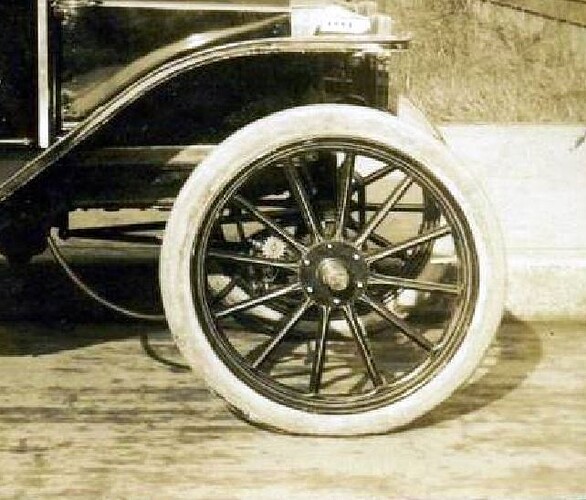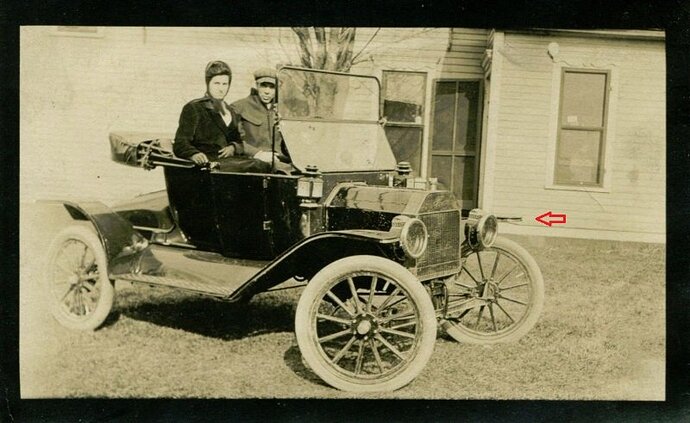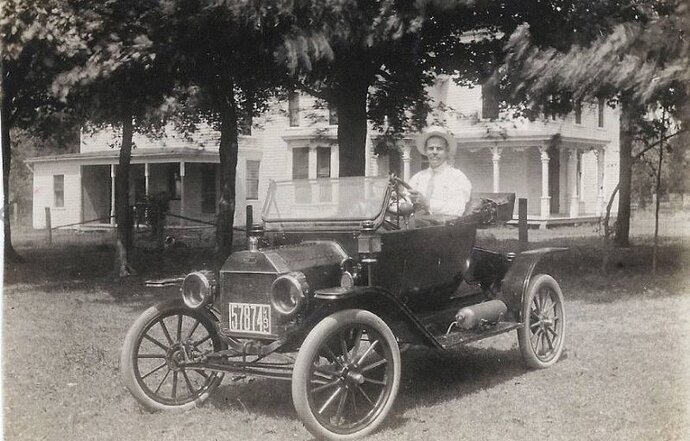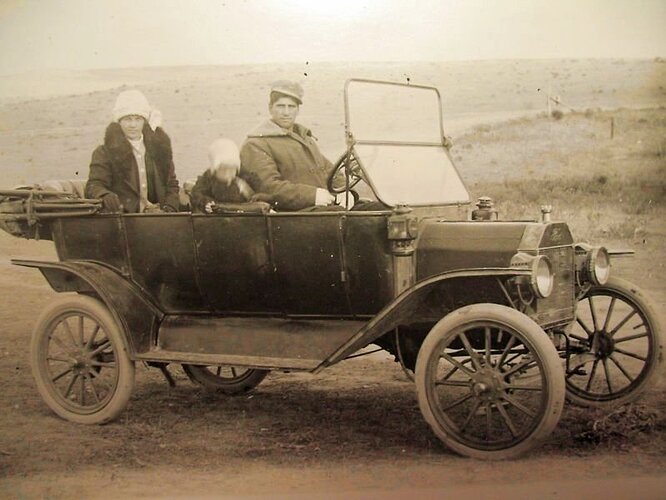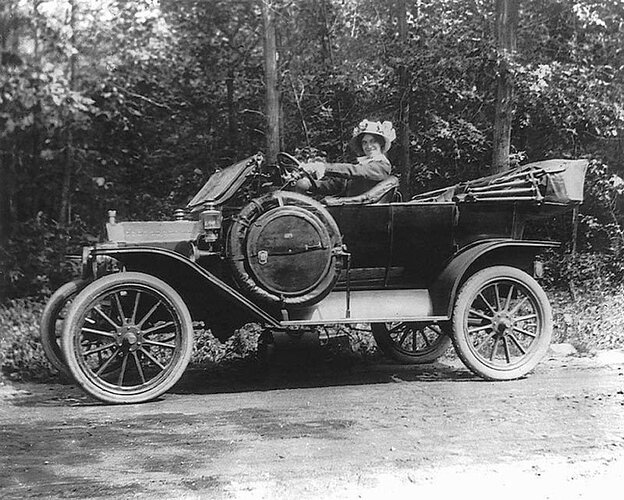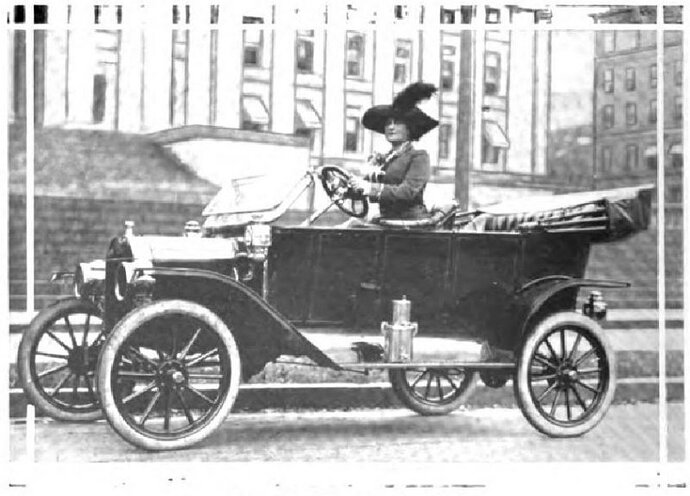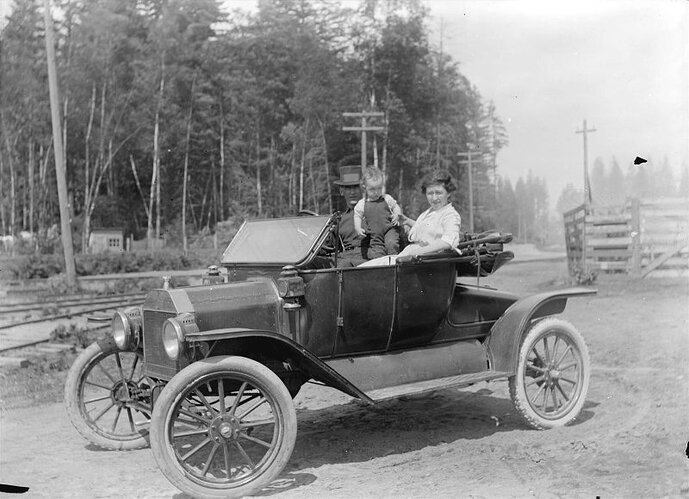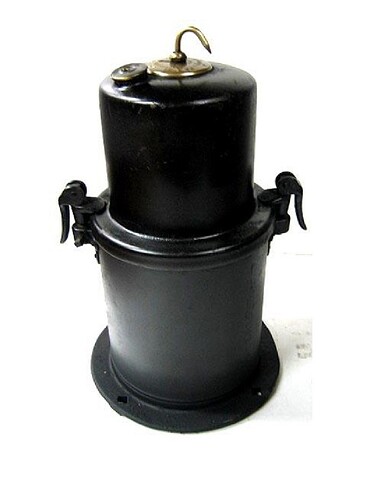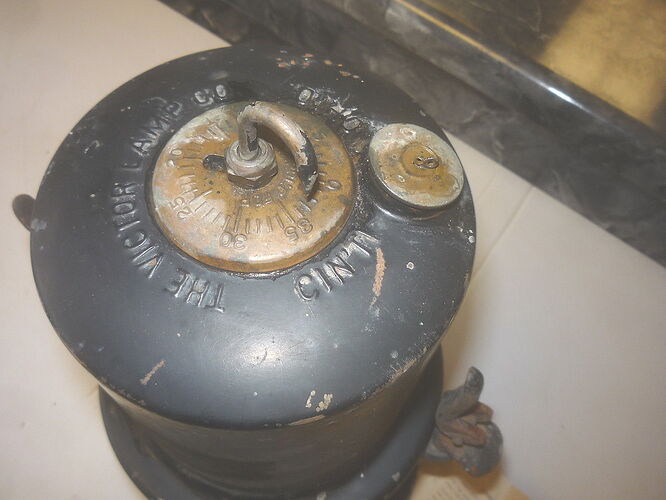This is one of my favorite photos of the 1913 cars. The beaded turtle deck usually associated with 1914 style cars is clearly on this 1913. Another feature is the pin striping on the wheels which may have lasted into the 1914 style.
This 1913 photo shows the short bill front fender. I believe that is an early 1913 feature but those more informed please comment. Also, the turtle does not have the beaded edge as shown in the first photo. The wheels also appear to have pin stripes but driver hasn’t been keeping up with car washing and makes it hard to see. The John Brown side lamps are jeweled and he has his headlamp doors opening toward the radiator. I believe Jay posted this photo several years ago.
No bills on any T front fenders 1913 or 1914 model year. There are a couple of different styles of 1913 front fender, none have bills like 1912 or 1915 fenders do.
Another early 1913 with a Prest-O-Lite “B” tank instead of a carbide generator. Ford shipped some cars from the factory POL equipped. A popular and practical upgrade for acetylene headlight or starter use.
A well kept 1913 Touring. Photo is not clear enough to tell if body has pin stripes but the wheels do. John Brown 16 gas headlamps and Stewart speedometer equipped. The passenger side John Brown 16 seems to be his “high” beam. The speedometer swivel needs to be rotated forward to pick up that cable a bit before he clotheslines a squirrel.
Two of the above photos show the early short billed front fender, which are original to both of my early '13 Fords. Another item that is rarely seen is the windshield with two equal halves, top and bottom. Mine is a Rands.
Not so new but a family car for sure. It is clear the rear door is “up” almost the width of the bead due to the weak 1913 touring car body design. This problem was not solved until the introduction of the 1914 style Beaudette bodied touring cars in July 1913 as noted in the Archives.
E&J headlamps have been electrified on this one and little bit gets to ride in the front seat.
Thanks for posting GREAT pictures along with explanations.
Here is a 1913 with the Rands windshield with the top and bottom panels the same width. Also, note the early front fender.
That is quite a nice accessory tire side mount with what appears to be a small storage container in the center. Electric horn has also been added along side the bulb horn. The car seems to have after-market electric headlights and all brass E&J side lamps.
Classy set up including the driver who is ready to hit the road in style … the moment frozen in time!
Here is another example of a “Brassy 1913”.
Appears to be a new 1913 body slipped onto a 1912 chassis.
Note the 1912 style fenders, billed front fenders and touring rear fenders, brass carbide generator, E&J brass headlights and side lamps and finished up with a forward folding brass Automatic windshield to line up with the later top.
Appears to be a very early 1913 model made in 1912. Note the striping on the body and all brass lamps and generator. The horn appears to be black and brass.
Interesting photo - I agree the front fenders appear to be 1912. Rear fenders cannot be 1912, those would not be able to fit a 1913 body. The carbide generator is a brass E&J unit, consistent with the set being all the same brand.
Both of my cars have the short bill. It is the same depth as the rest of the fender skirt, but definitely sticks out in front.
Nice detail on an interesting 1913 RHD runabout. Black & Brass lamps.
E & J side lamps (could be CLASCO) and what appear to be electrified John Brown 16 headlamps.
The photo above is interesting. It appears to me Ford made two styles of front fenders. Lipped, and non lipped. However, the lip I’m talking about is not the one above, and is clearly shown in some of the above photos. The early taillight bracket is obvious in the above photo.
The real early '13 models made in 1912 were like that.
The Canadian cars used different fenders.
Here is a rather new 1913 with what may be a complete set of Victor lighting equipment for 1913. The Victor No. 1 acetylene headlamps easily spotted by the three bonnet vents in a line, the Victor carbide generator with the “hook” drop indicator on top. Side lamps appear to be Victor with the dainty “round” type tail lamp harder to tell but the little black hood of that tail lamp just sticking out from behind the rear fender… nice top cover on this one too.
Nice one Ken. I don’t think Victor made their own carbide generator, appears to be a Corcoran generator on the running board.
Victor Lamp Company made Black & Brass generators and unlike the other manufacturers, Victor marked (embossed) the company name on some of the later production. The most obvious difference from Victor and the other manufacturers being the brass “hook” style water metering valve on top and the vertical acting latches. What is consistent with the Corcoran generator (E&J, John Brown as well), is the latches that secure the water tank to the bottom. Corcoran Lamp and Victor Lamp were both located in Cincinnati, Ohio, and owned by Thomas Corcoran and his brothers. I have a Victor 4-hole mount as pictured below but no Corcoran to see if the tops interchange. I have an idea that they will since the bottoms have to fit original Model T running board generator hole spacing.

